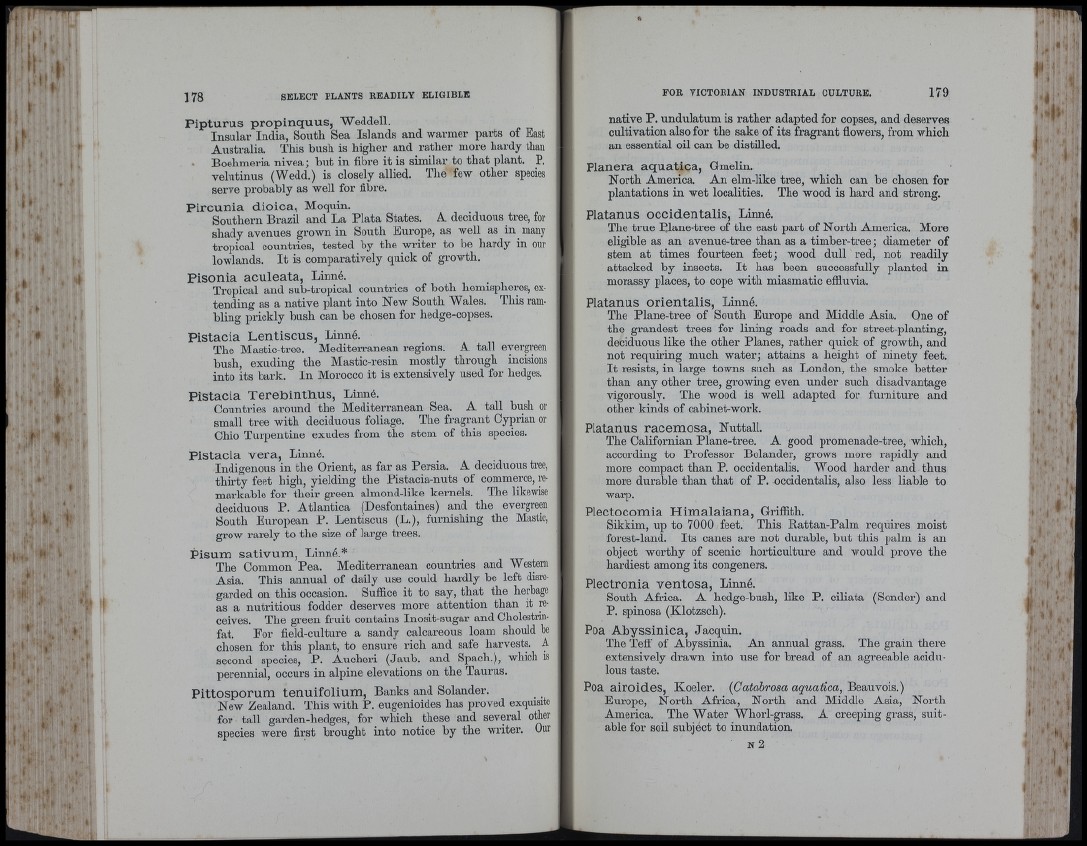
Pipturus propinquusj Weddell.
Insular India, South Sea Islands and warmer parts of East
Australia. This bush is higher and rather more hardy than
Boehmeria nivea; but in fibre it is similar to that plant. P,
velutinus (Wedd.) is closely allied. The few other species
serve probably as well for fibre.
Pircunia dioica, Moquin.
Southern Brazil and La Plata States. A deciduous tree, for
shady avenues grown in South Europe, as well as in many
tropical countries, tested by the writer to be hardy in our
lowlands. I t is comparatively quick of growth.
Pisonia aculeata, Linné.
Tropical and sub-tropical countries of both hemispheres, extending
as a native plant into New South W^ales. Ihis rambling
prickly bush can be chosen for hedge-copses.
Pistacia Lentiscus, Linné.
The Mastic-tree. Mediterranean regions. A tall eyerp^een
bush, exuding the Mastic-resin mostly through incisions
into its bark. In Morocco it is extensively used for hedges.
Pistacia Terebinthus, Linné.
Countries around the Mediterranean Sea. A tall bush or
small tree with deciduous foliage. The fi-agrant Cyprian or
Chio Turpentine exudes from the stem of this species.
Pistacia vcra, Linné.
Indigenous in the Orient, as far as Persia. A deciduous tree,
thirty feet high, yielding the Pistacia-nnts of commerce, remarkable
for tlieir green almond-like kernels. The likewise
deciduous P. Atlantica (Desfontaines) and the evergreen
South European P. Lentiscus (L.), furnishing the Mastic,
grow rarely to the size of large ti-ees.
Pisum sativum, Linné.*
The Common Pea. Mediterranean countries and Western
Asia. This annual of daily use could hardly be left disregarded
on this occasion. Suffice it to say, that the herbage
as a nutritious fodder deserves more attention than it receives.
The green fruit contains Inosit-sugar and Cliolestrin-
fat. Eor field-culture a sandy calcareous loam should be
chosen for this plant, to ensure rich and safe harvests. A
second species, P. Aucheri (Jaub. and Spacli.), whicb is
perennial, occurs in alpine elevations on the Taurus.
Pittosporum tcnuifolium. Banks and Solander.
New Zealand. This with P. eugenioides has proved exquisite
for tall garden-hedges, for which these and several otber
species were first brought into notice by the writer. Oui
native P. undulatum is rather adapted for copses, and deserves
cultivation also for the sake of its fragrant flowers, from which
an essential oil can be distilled.
Planera aquatica, Gmelin.
North America. An elm-like tree, which can be chosen for
plantations in wet localities. The wood is hard and strong.
Platanus occidentalis, Linné.
The true Plane-tree of the east part of North America. More
eligible as an avenue-tree than as a timber-tree; diameter of
stem at times fourteen feet; wood dull red, not readily
attacked by insects. I t has been successfully planted in
morassy places, to cope with miasmatic effluvia.
Platanus orientalis, Linné.
The Plane-tree of South Europe and Middle Asia. One of
the grandest trees for lining roads and for street-planting,
deciduous like the other Planes, rather quick of growth, and
not requiring much water; attains a height of ninety feet.
I t resists, in large towns such as London, the smoke better
than any other tree, growing even under such disadvantage
vigorously. The wood is well adapted for furniture and
other kinds of cabinet-work.
Platanus racemosa, Nuttall.
The Californian Plane-tree. A good promenade-tree, which,
according to Professor Bolander, grows more rapidly and
more compact than P. occidentalis. Wood harder and thus
more durable than that of P. occidentalis, also less liable to
warp.
Plectocomia Himalaiana, Griffith.
Sikkim, up to 7000 feet. This Rattan-Palm requires moist
forest-land. Its canes are not durable, but this jialm is an
object worthy of scenic horticulture and would prove the
hardiest among its congeners.
Plectronia ventosa, Linné.
South Africa. A hedge-bush, like P. ciliata (Sonder) and
P. spinosa (Klotzscb).
Poa Abyssinica, Jacquin.
The Tefi“ of Abyssinia. An annual grass. The grain there
extensively drawn into use for bread of an agreeable acidulous
taste.
Poa airoides, Koeler. {Catabrosa aquatica, Beau vois.)
Europe, North Africa, North and Middle Asia, North
America. The Water Whorl-grass. A creeping grass, suitable
for soil subjéct to inundation.
N 2
¥ ;
H r '